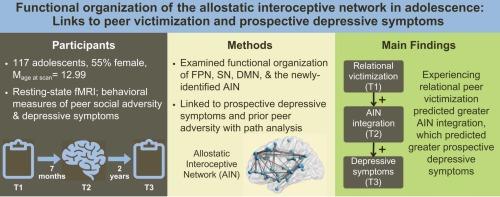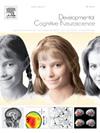Functional organization of the allostatic interoceptive network in adolescence: Links to peer victimization and prospective depressive symptoms
IF 4.9
2区 医学
Q1 NEUROSCIENCES
引用次数: 0
Abstract
The present study examines the role of brain network organization in the prospective prediction of adolescent depressive symptoms and links to the social and psychological context. Using a path model with data from a larger longitudinal study of adolescents beginning in 6th-8th grade (N = 117, 55 % female, Mage at scan= 12.99), we first established that organizational properties of brain networks theoretically linked to depression predicted greater depressive symptoms two years later. Specifically, when controlling for gender and initial depression, greater global efficiency of the allostatic interoceptive network (AIN) and greater segregation of the frontoparietal network (FPN) from the salience network (SN) predicted depressive symptoms an average of two years later. Linking these neural findings to psychological individual differences, we found that self-reported rumination mediated the effect of AIN global efficiency on prospective depressive symptoms. We further linked these neural findings to the social context by demonstrating that greater self-reported relational peer victimization prospectively predicted AIN global efficiency. Collectively, these findings situate the emergence of adolescent depressive symptoms as a confluence of brain organization properties, perceived social rejection, and individual differences in rumination.

青少年适应内感受网络的功能组织:与同伴伤害和预期抑郁症状的联系。
本研究探讨了大脑网络组织在青少年抑郁症状的前瞻性预测中的作用,以及与社会和心理环境的联系。使用一个路径模型,该模型的数据来自于对6 -8年级开始的青少年的更大的纵向研究(N = 117,55 %女性,扫描时的图像= 12.99),我们首先确定了与抑郁有关的大脑网络的组织特性在理论上预测了两年后更大的抑郁症状。具体来说,在控制性别和初始抑郁的情况下,适应内感网络(AIN)的整体效率更高,额顶叶网络(FPN)与显著性网络(SN)的分离程度更高,平均两年后预测抑郁症状。将这些神经发现与心理个体差异联系起来,我们发现自我报告的反刍介导了AIN整体效率对预期抑郁症状的影响。我们进一步将这些神经研究结果与社会背景联系起来,证明了更大的自我报告的关系同伴受害前瞻性地预测了AIN的整体效率。总的来说,这些发现将青少年抑郁症状的出现定位为大脑组织特性、感知到的社会排斥和反刍的个体差异的汇合。
本文章由计算机程序翻译,如有差异,请以英文原文为准。
求助全文
约1分钟内获得全文
求助全文
来源期刊

Developmental Cognitive Neuroscience
NEUROSCIENCES-
CiteScore
7.60
自引率
10.60%
发文量
124
审稿时长
6-12 weeks
期刊介绍:
The journal publishes theoretical and research papers on cognitive brain development, from infancy through childhood and adolescence and into adulthood. It covers neurocognitive development and neurocognitive processing in both typical and atypical development, including social and affective aspects. Appropriate methodologies for the journal include, but are not limited to, functional neuroimaging (fMRI and MEG), electrophysiology (EEG and ERP), NIRS and transcranial magnetic stimulation, as well as other basic neuroscience approaches using cellular and animal models that directly address cognitive brain development, patient studies, case studies, post-mortem studies and pharmacological studies.
 求助内容:
求助内容: 应助结果提醒方式:
应助结果提醒方式:


